
A piñata is a container, often made of papier-mâché, pottery, or cloth, that is decorated, filled with candy, and then broken as part of a celebration. Piñatas are commonly associated with Mexico. The idea of breaking a container filled with treats came to Europe in the 14th century, where the name, from the Italian pignatta, was introduced. The Spanish brought the European tradition to Mexico, although there were similar traditions in Mesoamerica, such as the Aztecs' honoring the birthday of the god Huītzilōpōchtli in mid-December. According to local records, the Mexican piñata tradition began in the town of Acolman, just north of Mexico City, where piñatas were introduced for catechism purposes as well as to co-opt the Huitzilopochtli ceremony. Today, the piñata is still part of Mexican culture, the cultures of other countries in Latin America, as well as the United States, but it has mostly lost its religious character.

Venustiano Carranza is one of the 16 boroughs of Mexico City. The borough was formed in 1970 when the center of Mexico City was subdivided into four boroughs. Venustiano Carranza extends from the far eastern portion of the historic center of Mexico City eastward to the Peñón de los Baños and the border dividing the then Federal District from the State of Mexico. Historically, most of the territory was under Lake Texcoco, but over the colonial period into the 20th century, the lake dried up and today the area is completely urbanized. The borough is home to three of Mexico City's major traditional markets, including La Merced, the National Archives of Mexico, the Palacio Legislativo de San Lázaro, the TAPO intercity bus terminal and the Mexico City Airport.

Alebrijes are brightly colored Mexican folk art sculptures of fantastical (fantasy/mythical) creatures. The first alebrijes, along with the invention of the term, originated with Mexico City cartonero Pedro Linares. Linares often told that in 1936, he fell very ill, and while he was in bed unconscious, he dreamt of a strange place resembling a forest. There, he saw trees, rocks, clouds that suddenly turned into something strange, and some kind of animals but unknown animals. He saw "a donkey with butterfly wings, a rooster with bull horns, and a lion with an eagle head", and all of them were shouting one word, "Alebrijes! Alebrijes! Alebrijes!" Before this happened, he was already a cartonero artisan. Upon recovery, he began recreating the creatures he had seen in cartonería, the making of three-dimensional sculptures with different types of papers, strips of papers and engrudo.
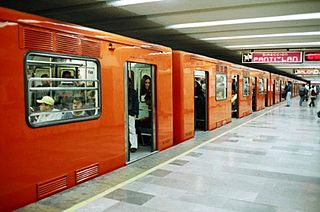
Merced is an underground station on Line 1 of the Mexico City Metro. It is located in the Venustiano Carranza borough, slightly to the east of the centre of Mexico City. The station building was designed by Félix Candela, and it was opened on 4 September 1969.
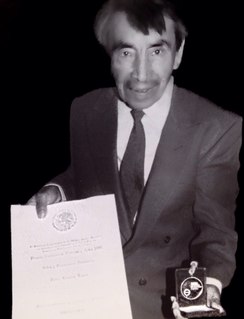
Pedro Linares López was a Mexican artist born in Mexico City known for coining the word and the concept Alebrije and its plural form Alebrijes that are zoomorphic Cartonería figures.

A tianguis is an open-air market or bazaar that is traditionally held on certain market days in a town or city neighborhood in Mexico and Central America. This bazaar tradition has its roots well into the pre-Hispanic period and continues in many cases essentially unchanged into the present day. The word tianguis comes from tiyānquiztli or tianquiztli in Classical Nahuatl, the language of the Aztec Empire. In rural areas, many traditional types of merchandise are still sold, such as agriculture supplies and products as well as modern, mass-produced goods. In the cities, mass-produced goods are mostly sold, but the organization of tianguis events is mostly the same. There are also specialty tianguis events for holidays such as Christmas as well as for particular types of items such as cars or art.

The La Merced Market is a traditional public market located in the eastern edge of the historic center of Mexico City and is the largest retail traditional food market in the entire city. The area, also called La Merced, has been synonymous with commercial activity since the early colonial period when traders arrived here from other parts of New Spain. At one time, nearly the entire neighborhood was filled with market stalls and in the 1860s it was decided to build a permanent market on the grounds of the old La Merced monastery. In the first half of the 20th century, this market was the major wholesaler for the entire city. This ended when the Central de Abasto was opened in the 1980s, but La Merced remains the largest traditional retail market. The market area is also known for flagrant prostitution in which women can be seen soliciting at all hours of the day and night. It is estimated that about one third of these prostitutes are underage.
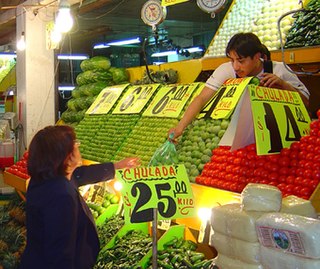
The Central de Abasto is Mexico City’s main wholesale market for produce and other foodstuffs run similarly to traditional public markets. It was constructed to be the meeting point for producers, wholesalers, retailers and consumers for the entire country. Located in the eastern borough of Iztapalapa, it is the most important commercial establishment in Mexico and the largest of its kind in the world. The market handles over 30,000 tons of merchandise daily, representing 80% of the consumption of the Mexico City metropolitan area. The market was established on former farmland to ease congestion in the historic center of Mexico City.

Mercado Jamaica is one of Mexico City’s traditional public markets where various vendors sell their wares in an established location. This market began in the 1950s as part of efforts to urbanize the markets in the area. The market is located on the corner of Congreso de la Union and Avenida Morelos, just southeast of the historic center of the city. Although it is one of the main markets for souvenirs, produce and meat, it is best known for its flowers and ornamental plants. There are 1,150 stands dedicated to the selling of cut flowers, flower arrangements, ornamental plants and accessories such as flowerpots. The market offers about 5,000 types of flowers and plants, mostly foreign, but there is a number of native Mexican species available, including some gathered directly from the wild.

La Lagunilla Market is a traditional public market in Mexico City, located about ten blocks north of the city's main plaza, in a neighborhood called La Lagunilla. The market is one of the largest in the city and consists of three sections: one for clothing, one for furniture and one for foodstuffs, mostly selling to lower income customers. The market is surrounded by small stores and street vendors, many specializing in furniture and dresses and other needs for formal occasions. On Sundays, the number of street vendors grows significantly, a weekly “tianguis” market called a baratillo which traditionally sells used items. One section of this baratillo has developed into a market for antiques, which has attracted higher income customers and even famous ones such as Carlos Monsiváis.
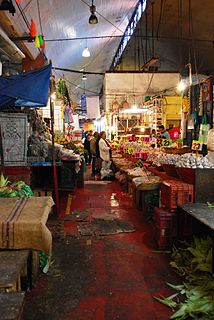
Traditional fixed markets in Mexico are multiple-vendor markets permanently housed in a fixed location. They go by a variety of names such as "mercados públicos", "mercados municipales" or even more often simply "mercados" (markets). These markets are distinct from others in that they are almost always housed in buildings owned and operated by the local government, with numerous stands inside rented by individual merchants, who usually sell produce and other basic food staples. This market developed in Mexico as a way to regulate pre Hispanic markets called tianguis. These tianguis markets remain in Mexico, with the most traditional held on certain days, put up and taken down the same day, much the way it was done in Mesoamerica.

Cartonería or papier-mâché sculptures are a traditional handcraft in Mexico. The papier-mâché works are also called "carton piedra" for the rigidness of the final product. These sculptures today are generally made for certain yearly celebrations, especially for the Burning of Judas during Holy Week and various decorative items for Day of the Dead. However, they also include piñatas, mojigangas, masks, dolls and more made for various other occasions. There is also a significant market for collectors as well. Papier-mâché was introduced into Mexico during the colonial period, originally to make items for church. Since then, the craft has developed, especially in central Mexico. In the 20th century, the creation of works by Mexico City artisans Pedro Linares and Carmen Caballo Sevilla were recognized as works of art with patrons such as Diego Rivera. The craft has become less popular with more recent generations, but various government and cultural institutions work to preserve it.
The Linares family in Mexico City are among the best known practitioners of a craft known as “cartonería” or the use of papier-mâché to create hard sculptured objects. They have an international reputation for the creation of forms such as skeletons, skulls, Judas figures and fantastical creatures called alebrijes. While the family’s history in the craft can be traced back as far as the 18th century, it was the work of Pedro Linares, who invented the alebrijes, that made the family famous. Pedro’s work became internationally famous through the patronage of artists of Diego Rivera and the promotion of it at the 1968 Olympic Games and through documentaries. Pedro died in 1992, but his sons and grandsons continue with the craft, which is sold internationally and have been exhibited in museums in various countries.

The Mexico City Alebrije Parade is an annual event to honor Mexican handcrafts and folk art, especially a hard kind of papier-mâché called “cartonería” and the creation of fantastic figures with it called “alebrijes.” Alebrijes are chimera-like creatures credited to artisan Pedro Linares painted in bright colors. The alebrijes for the parade are larger than anything Linares created, up to four meters in height and three meters in width. The parade begins on midday on a Saturday in late October in the historic center of Mexico City. The giant creatures are accompanied by musicians, clowns, people in costume and more, giving the event a Carnival-like atmosphere. After the parade the creations are judged with prizes awarded. There are also related literary and musical compositions.

Lupita dolls, also known as cartonería dolls, are toys made from a very hard kind of papier-mâché which has its origins about 200 years ago in central Mexico. They were originally created as a substitute for the far more expensive porcelain dolls and maintained popularity until the second half of the 20th century, with its availability of plastic dolls. Today they are made only by certain artisans’ workshops in the city of Celaya, as collectors’ items. Since the 1990s, there have been efforts to revitalize the crafts by artists such as María Eugenia Chellet and Carolina Esparragoza sponsored by the government to maintain traditional techniques but update the designs and shapes.

Traditional Mexican handcrafted toys are those made by artisans rather than manufactured in factories. The history of Mexican toys extends as far back as the Mesoamerican era, but many of the toys date to the colonial period. Many of these were introduced as teaching tools by evangelists, and were associated with certain festivals and holidays. These toys vary widely, including cup and ball, lotería, dolls, miniature people, animals and objects, tops and more—made of many materials, including wood, metal, cloth, corn husks, ceramic, and glass. These toys remained popular throughout Mexico until the mid-20th century, when commercially made, mostly plastic toys became widely available. Because of the advertising commercial toys receive and because they are cheaper, most traditional toys that are sold as handcrafts, principally to tourists and collectors.

The presence of street vendors in Mexico City dates back to pre-Hispanic era and over the centuries the government has struggled to control it, with most recently a clearing of downtown streets of vendors in 2007, but despite this there is a persistent presence of many thousands illegally. Even after oscillating between the realms of legality and illegality, street vending in Mexico and even in other parts of the world, is not the exception but rather has been a norm when it comes to commercial activities. In 2003, it was estimated that there were 199,328 street vendors in Mexico City.
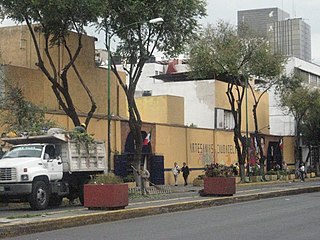
The Ciudadela Market is a traditional style Mexican market which specializes in the sale of Mexican handcrafts and folk art, located in the southwest corner of the historic center of Mexico City. The market is the first of its kind in the country, established just before the 1968 Summer Olympics to promote this aspect of Mexico's cultural heritage. It is home to over 350 vendors, mostly small operators selling to Mexican and foreign tourists.

Handcrafts and folk art in Mexico City is a microcosm of handcraft production in most of the rest of country. One reason for this is that the city has attracted migration from other parts of Mexico, bringing these crafts. The most important handcraft in the city is the working of a hard paper mache called cartonería, used to make piñatas and other items related to various annual celebrations. It is also used to make fantastic creatures called alebrijes, which originated here in the 20th century. While there are handcrafts made in the city, the capital is better known for selling and promoting crafts from other parts of the country, both fine, very traditional wares and inexpensive curio types, in outlets from fine shops to street markets.

Sotero Lemus Gervacio is a cartonería artisan who is known for his traditional toymaking and large figures. Although situated in the Mexico City metro area, Lemus' work and style is based on the cartonería traditions of Celaya, Guanajuato. He is a fourth-generation "cartonero," from a family who is noted in Celaya for its work. Lemus' work has been sold and exhibited in various parts of the world, including the United States, Europe and Central America. Since 2005, he has also been involved in the making of much larger works for exhibition, starting with a twelve-meter tall image of Don Quixote on horseback, which toured Mexico for about a year.





















